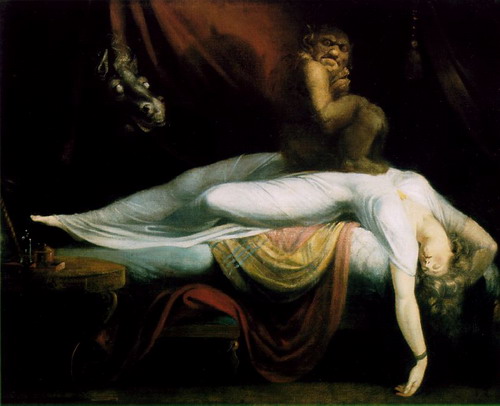The Fall of the House of Usher. Setting and plot study.

This is the summary of a presentation I have done about The Fall of the House of Usher.
The unity of effect is a unity of tone
Looking for information I found out that Poe believed that the best way to obtain a certain effect on the reader was to keep a unity of tone through the whole text. I think that this principle is perfectly illustrated in this tale.
Each detail is strategically designed to introduce us inside the story, just as the narrator is introduced in the House of Usher.
Gothic setting: irrational fear. Its reflection on the narrator.
This is a Gothic setting, and provokes an irrational fear that attacks common sense, as we can see in the mental condition of the narrator (expressed in page 1 “I know not how it was-but, with the first glimpse of the building, a sense of insufferable gloom pervaded my spirit”). He is the representative of the civilized society, who goes into a mysterious place –because we do not know where the Ushers live, but it is suggested that the house is placed far away from any city (page 1, “passing alone, on horseback, through a singularly dreary tract of the country”).
Description of the House of Usher –skull-like. Reflect of Roderick.
The House of Usher is very old, and dominates the desolate country, similar to a watchtower. With bleak walls, vacant and eye-like windows, Poe is describing a skull. We need to connect this description with Roderick’s appearance (page 3, “a cadaverouness of complexion, an eye large, liquid...” and then “the ghastly pallor of the skin”). Since both family and inheritance share the same name, “House of Usher”, they also share their life and destiny. That’s the reason of their mutual influence: Roderick blames the building atmosphere and disposition for his illness, but his condition also intensifies it, because he recreates his imagination there. I find remarkable that the narrator, at the very beginning, says exactly the same (page 1, at the end of the first paragraph).
An example of this mutal influence is Roderick’s studio. Instead of suggesting a lively existence, the chaos in his room suggests “an air of stern, deep and irredeemable gloom”. The interior of the house reflects the interior of Roderick’s mind.
This explains why the main character, Roderick, appears so late in a short story like this (in page 3). The description of the house is also a description of its owner.
The metaphor of the fissure
When the narrator is describing the house physically, he notices a fissure, that extends “from the roof of the building in front, and made its way down the wall in a zigzag direction”. That fissure shows that the house is in danger of collapsing- but also shows, since its relation with the family, that Roderick’s mental condition and Madeline’s physical condition are in danger too.
Roderick’s prophecy about agitations
Roderick is aware of that situation, as he explains in page 3, that he “shudders at the thought of any (...) incident, which may operate upon this intolerable agitation of soul”. The smallest agitation will crumble down the house and his mind.
Ushered into another world, the world of Usher
Another remarkable fact is that Poe uses the word “ushered into” when the narrator is introduced to the studio of his friend. “Usher” as a verb means ‘to take sb where they should go’ or ‘to make sth new begin”. Poe may use this specific term because entering in the House of Usher is entering into another world, designed by Roderick’s madness.
The fissure again. The tarn as River Styx. Threshold to another world
Returning to the fissure, it is said that “became lost in the sullen waters of the tarn” that lays by the building. It has black and lurid, very calm waters. When he looks down and sees himself and the house reflected on it, his fear becomes almost overwhelming. As it is described, reminds me to the River Styx, which in the greek mythology separates the living from the dead, it was at the entrance of Hell. This intensifies the image of the House of Usher as a threshold to another world.
Terrying world
This world has a very frightening atmosphere, which gets even worst after Madeline’s death. If at the beginnig the narrator realizes it, at the end, he tries to explain it as a natural phenomenon. In the nineteenth century, people believed that tarns gave off vapours that produced mental illnesses (as we can see in page 8, fourth paragraph) Maybe he changes his mind as the last attempt to keep himself away from madness.
The outcome. Storms and climax of Roderick’s madness. Runaway of a premature burial. Linked fates, swallowed by the tarn.
When the spirits of the two friends are more altered, outside the weather is altered too (page 8, same paragraph). Something terrible is going to happen, and it happens parallel to the reading of a romance. Roderick reaches the climax of his madness and Madeline escapes from her premature burial. In a white dress stained with blood, she attacks her brother in a way similar to what he had said on page 3, so he is really a victim of the fears he had anticipated.When the twins collapsed, both physically and mentally, the House collapses too, because of their linked fates. The narrator managed to escape in the last moment, away from death and madness, and sees them swallowed by the tarn.
Gloomy end. Against Death man can do NOTHING.
But, altough the House disappeared, the tarn and the dead trees, and the shadows survived, symbols of the Death against who men can do nothing.
0 comentarios